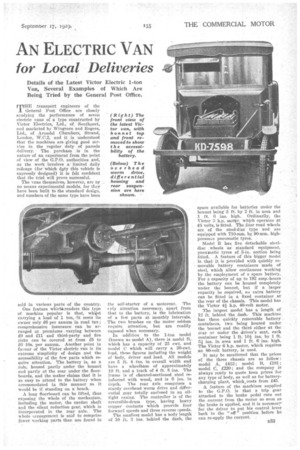AN ELECTRIC VAN
Page 67

If you've noticed an error in this article please click here to report it so we can fix it.
for Local Deliveries
Details of the Latest Victor Electric 1-ton Van, Several Examples of Which Are Being Tried by the General Post Office.
/TIRE transport engineers of the .1 General Post Office are closely studying the performance of seven electric vans of a type constructed by Victor Electrics, Ltd., of Southport, end marketed by Wingrove and Rogers, Ltd., of Arundel Chambers, Strand, London, W.C.2, and it is understood that the machines are giving good service in the regular duty of parcels delivery. The purchase is in the nature of an experiment from the point of view of the G.P.O. authorities and, as the work involves a limited daily mileage (for which dpty this vehicle is expressly designed) it is felt confident that the trial will prove successful.
The vans themselves, however, are by no means experimental models, for they have been built to the standard design, and numbers of the same type have been sold in various parts of the country.
One feature whichl.renders this type of machine popular is that, whist carrying a load of 1 ton, it costs its owner only £6 per annum in road tax ; comprehensive insurance can be arranged at premiums varying between £0 and £11 and third-party and .fire risks can be covered at from 15 to £6 10s. per annum. Another point in favour of the Victor electric van is its extreme simplicity of design and the accessibility of the few parts which require attention. The battery is, as a rule, housed partly under the bonnet and partly at the rear under the floorboards, and the maker claims that it is as easy to attend to the battery when accommodated in this manner as it would be if standing on a. bench.
A. long floorboard can be lifted, thus exposing the whole of the mechanism, including the motor, the cardan shaft and the silent reduction gear, which is incorporated in the rear axle. The whole orrangement is said to comprise fewer working parts than are found in the self-starter of a motorcar. The ely attention necessary, apart from that to the battery, is the lubrication of a few parts at monthly intervals. The two brushes on the motor seldom require attention, but are readily exposed when necessary.
In addition to the 1-ton model (known as model A), there is model B, which has a capacity of 23 cwt. and model which will carry a 30-cwt. load, these figures including the weight of body, driver and load. All models are 5 ft. 4 •ins, in overall width and have a wheelbase of approximately 10 ft. and a track of 4 ft. 8 ins. The frame is of channel-sectioned steel reinforced with wood, and is 6 ins. in depth. The rear axle comprises a sturdy overhead worm drive and differential gear totally enclosed in an oiltight casing. The controller is of the reversible-drum type, having heavy copper contacts which provide four forward speeds and three reverse speeds.
The smallest model has a body length of 10 ft. 3 ins, behind the dash,. the space available for batteries under the bonnet being 3 ft. by 2 ft. in area and 1 ft. 6 ins. high. Ordinarily, the Victor Zi h.p. motVr. which operates at 43 volts, is fitted. The four road wheels are of the steel-disc' type and are equipped with 710-mm. by 90-mm. highpressure pneumatic tyres.
Model B has five detachable steeldisc .wheels as standard equipment, pnetmatic tyres of 5-in. section being fitted. A feature of this bigger model is that it is provided with quickly removable battery containers made of steel, which allow continuous working by the employment of a spare battery. For a capacity of up to 192 amp.-hours the battery can be housed completely under the bonnet, but if a larger capacity be required, au extra battery can be fitted in a fixed container at the rear of the chassis. • This model has the Victor 41 h.p. 40-volt motor.
The largest model has a length of 12 ft. behind the dash. This machine has three quickly removable battery containers, two being housed under the bonnet and the third either at the rear or under the driver's seat, each container being 1 ft. 10i ins. by 1 ft. 5/ ins, in area and 1 ft. 6 ins. high. The Victor 6 h.p. motor, which requires an 80-volt battery, is used.
It may be mentioned that the prices of the three chassis are as follow : model A, :1413; model B, £181; model C, £220; and the company is always ready to quote keen prices for any type of body, as well as for batterycharging plant, which, costs from £45.
A feature of the machines supplied to the G.P.O. is that a trip gear attached to the brake pedal cuts out the current from the motor so soon as the brake is applied, and it is necessarr for the driver to put his control lever back to the " off " position before he can re-apply the current.




















































































































